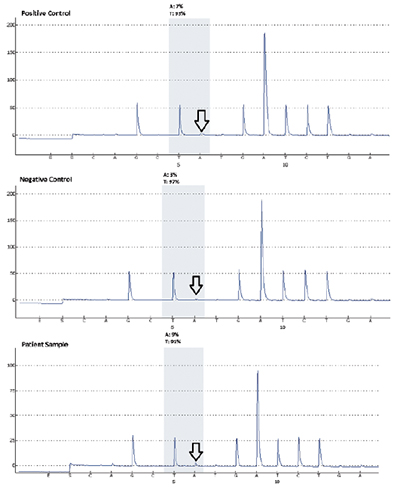
Fig. 3. Appropriate positive and negative controls are seen (as indicated by the arrows) for the BRAF V600E pyrosequencing assay followed by results of the patient sample which indicate the presence of a mutation. The test sensitivity or low limit of detection is validated at five percent mutant allele.
For this case, we first attempted to manually microdissect the tumor clusters from one of the other positive lymph nodes. LCM was performed as a salvaging means to recover DNA with higher tumor content after the pyrosequencing results showed an equivocal result. Applying LCM does have disadvantages. The equipment required for the process can be expensive and the process itself is time-consuming and labor-intensive. Also, when performing this technique, these tissue sections are not coverslipped and stained in gray and white colors, which results in a limited optical resolution that sometimes makes it difficult to identify tumor from normal tissue. This might be why LCM has largely been replaced by manual tissue microdissection that requires only designation of tumor areas by a pathologist followed by direct tissue scraping from the unstained slides. Nevertheless, the role of LCM in precise tissue microdissection in certain clinically challenging cases cannot be played by a manual-based approach.
Conclusion. In summary, this case shows the utility of certain microdissection techniques like LCM, especially in cases in which there may be only small microfoci of tumor cells present. In these situations, techniques that allow for precise dissection with minimized contamination from non-neoplastic cells are essential for quality molecular characterization of the tumor that may have potential therapeutic implications for the patient.
- Fend F, Raffeld M. Laser capture microdissection in pathology. J Clin Pathol. 2000;53(9):666–672.
- Hunt JL, Finkelstein SD. Microdissection techniques for molecular testing in surgical pathology. Arch Pathol Lab Med. 2004;128(12):1372–1378.
- Poynter JN, Elder JT, Fullen DR, et al. BRAF and NRAS mutations in melanoma and melanocytic nevi. Melanoma Res. 2006;16(4):267–273.
- Paik PK, Arcila ME, Fara M, et al. Clinical characteristics of patients with lung adenocarcinomas harboring BRAF mutations. J Clin Oncol. 2011;29(15):2046–2051.
- Tang KT, Lee CH. BRAF mutation in papillary thyroid carcinoma: pathogenic role and clinical implications. J Chin Med Assoc. 2010;73(3):113–128.
- Jin M, Hampel H, Zhou X, et al. BRAF V600E mutation analysis simplifies the testing algorithm for Lynch syndrome. Am J Clin Pathol. 2013;140(2):177–183.
Dr. Sharma is a pathology resident (PGY3) and Dr. Wang is an assistant professor in the Department of Pathology and Laboratory Medicine at the University of Florida College of Medicine, Jacksonville, where Dr. Wang is medical director of molecular pathology.
[hr]Test yourself
Here are three questions taken from the case report. Answers are online now at www.amp.org/casereports and will be published next month in CAP TODAY.
1. Which of the following statements regarding laser capture microdissection is true?
a) The LCM technology was developed for research use only.
b) LCM is still used in certain clinical settings, especially when precision tissue microdissection is demanded for quality DNA samples with high wild type DNA proportion.
c) Manual tissue microdissection is cost-efficient and time-efficient and has replaced LCM clinically as the only means to isolate tumor DNA.
2. Manual tissue microdissection denotes:
a) Manually setting aside a piece of tumor tissue during specimen grossing for DNA preparation.
b) FFPE tissue blocks are manually punched followed by standard procedures of DNA isolation.
c) Tumor areas need to be designated and marked by a pathologist before the manual scraping of tissue from the unstained slides.
3. BRAF V600E mutation is indicated:
a) In metastatic malignant melanoma only as a companion test for targeted therapy.
b) In diagnosis of Lynch syndrome as a reflex test in patients with MSI-H genotype colorectal carcinoma.
c) As a companion test for non-small cell lung cancer as recommended (as standard practice) by the NCCN.
 CAP TODAY Pathology/Laboratory Medicine/Laboratory Management
CAP TODAY Pathology/Laboratory Medicine/Laboratory Management
